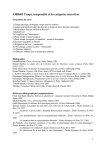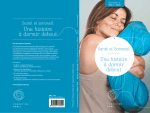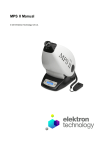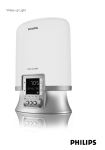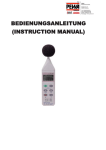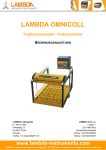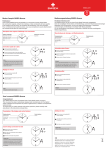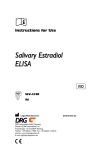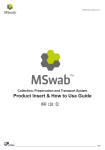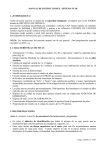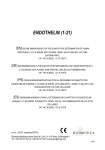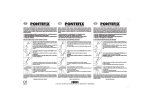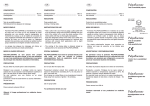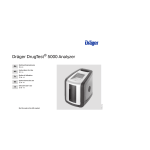Download 090216_EK-DSM - Sleep Check IFU CE
Transcript
Sleep Check Additional laboratory instructions for Direct Saliva Melatonin ELISA/RIA B-SLEEPCHECK16 16 profiles Revision date: 2009-02-16 BÜHLMANN LABORATORIES AG Baselstrasse 55 CH - 4124 Schönenbuch, Switzerland Tel.: +41 61 487 1212 Fax: +41 61 487 1234 [email protected] English page Deutsch Seite Francais page Italiano pagina 2 5 8 11 ENGLISH INTENDED USE The BÜHLMANN Sleep Check is intended for the accurate collection and handling of human saliva samples for the subsequent quantitative determination of the dim-light melatonin onset (DLMO) in human saliva (1-6). Quantification of Melatonin in saliva will be done with the Direct Saliva Melatonin ELISA/RIA from BÜHLMANN. All basic information concerning quantification step will be found in the corresponding instruction for use. DLMO can be calculated with the help of this manual. BACKGROUND INFORMATION DLMO is an important parameter for the diagnosis and treatment of circadian rhythm disorders. Endogenous melatonin, a hormone produced by the pineal gland during the dark phase of the day-night cycle, synchronizes circadian rhythms, especially the sleep/wake rhythm. Its secretion is controlled by an endogenous oscillator that is entrained by light. Melatonin concentration reaches the maximum saliva levels around 03:00-04:00 a.m., varying with chronotype, whereas diurnal levels are low to undetectable When endogenous melatonin starts to rise late, sleep/wake rhythm is delayed. Vice versa when it starts to raise early, sleep wake rhythm is advanced. Melatonin rhythm correlates strongly with circadian rhythms. Therefore DLMO is the most useful parameter to establish circadian rhythm disorders (4). The determination of Melatonin concentration in Saliva is a non invasive method. With the Sleep Check Saliva collection device it is possible to determine a partial 5 points Melatonin profile, around the client sleep time. The first collection point has to be collected three hours before the client sleep time, proceeded with a hourly Saliva collection 4 times. With the 5 points partial profile the determination of DLMO is possible in about 80% of all clients (pers. communication with Dr. M. Smits; Ede, NL). REAGENTS SUPPLIED Components Quantity Code Comments MATERIALS REQUIRED BUT NOT PROVIDED The Sleep Check is a concept for the calculation of the individual DLMO and contains the required sample collection devices. For quantification of the samples BÜHLMANN strongly propose to use either the BÜHLMANN Direct Saliva Melatonin ELISA or RIA: - Direct Saliva Melatonin ELISA (order code: EK-DSM) - Direct Saliva Melatonin RIA (order code: RK-DSM) PROCEDURAL NOTES FOR SPECIMEN COLLECTION Collect saliva using the BÜHLMANN Saliva Collection Device (Salivette® tube) delivered with the Sleep Check kit. One of these cotton swabs can absorb up to 3 ml of saliva. The procedure calls for <0.5 ml of saliva. Saliva collection is simple and can be performed in clients’ home at his convenience, but following precautions are recommended: Please read the instructions carefully before you start to collect saliva. The more carefully you follow the instructions, the more reliable the results will be. Client should set aside an evening for this test avoiding sporting activities and any intense efforts as far as possible. Light: Bright light can suppress melatonin production. Therefore, it is important to avoid bright light during the test. Muted lighting from a reading lamp or from the television is preferable. Eating: Nothing should be eaten during the collection time. The last meal must be taken at least 30 minutes before starting the collection. Bananas and chocolate should not be eaten during the entire day before the collection. Drinking: Drinks containing artificial colorants, caffeine (coffee, black or green tea, iced tea, cola) or alcohol are not allowed on the evening of the collection. Medicines: On the collection day, if possible, no aspirin and medicines that contain ibuprofen (Algiofor, Brufen, Dysmenol, Dolocyl, Ecoprofen) should be taken. If your sleep or sleep-wake rhythm is treated with melatonin, this must be discontinued at least one week before the collection. Each box contains: ® B-SB 5 Salivette ® 5 Salivette Labels Safety boxes 16 Big Envelope 16 -- For shipment to client Blue plastic Envelope 16 -- For reshipment to Lab Client Manual 16 -- Instructions for clients Client Data Form 16 -Table 1 One Sleep Check kit last for 16 individual partial profiles with 5 points of measurement. Using the BÜHLMANN Direct Saliva Melatonin ELISA (EK-DSM) for melatonin quantification the 16 individual partial profiles can be done with one kit. Revision date: 2009-02-16 2/16 BÜHLMANN direct saliva Melatonin ELISA COLLECTION SCHEME Five saliva samples must be collected during one evening. The time point of collection is depending on individual sleep time. The first collection has to be done three hours before the regular individual sleep time. The last collection point has to be collected one hour after the regular sleep time. Example: If the regular sleep time of the client is 11 pm, the first collection point has to be at 8 pm, afterwards every hour one saliva sample has to be collected (at 9 pm, 10pm, 11 pm and 12 pm). Example for Collection Time st nd Sleep time 1 2 8 pm 5pm 6pm 10 pm 7pm 8pm 12 pm 9pm 10pm 1 am 10pm 11pm COLLECTION MODE 1. Before you begin the collection, label the tubes. Start with label 1. Write on the label the client ID number assigned to you, your date of birth, the day you started the saliva collection and the first planned collection time. Then attach the label to the tube and do the same with tubes 2 – 5. Fill out the client information form. 2. 15 minutes before each saliva sample, you should rinse your mouth thoroughly with water rd th 3 7pm 9pm 11pm 12pm 4 8pm 10pm 12pm 1am 4th 5th th 5 9pm 11pm 1am 2am 3. Open the top of the tube (the cotton ball is in the top) and remove the top from the tube. Collection points 1 st 2nd 3rd 4. Put the cotton ball into your mouth straight from the top without touching it with your fingers. -3 hours Sleep time 5. Put the cotton ball between your teeth and cheek and move it around with your tongue for 3 – 5 minutes, until the cotton ball is thoroughly soaked with saliva. 6. Put the cotton ball straight into the tube from your mouth, without touching it with your fingers. 7. Using the top, push the cotton ball into the tube and put on the top. 8. Now repeat the whole of sequence 2 7 every hour to obtain 5 samples. 9. After having finished the collection period, put all tubes into the white plastic box and put the white box, together with the client information form, into the blue franked envelope. 10. Store the samples in the refrigerator until you dispatch them so that you can send them to the lab within 2 days (put them in the next mailbox). 11. Please make sure you send samples to the laboratory on Monday to Thursday only. Revision date: 2009-02-16 3/16 BÜHLMANN direct saliva Melatonin ELISA SPECIMEN SHIPMENT AND STORAGE After the integration of the Melatonin values on the graph, the DLMO time can be read out, on the Melatonin concentration of 4 pg/ml. In this example the DLMO of this client is around 23:15 pm. The safety box, containing the 5 labelled and used ® Salivette tubes together with the filled client form must be packed in the blue plastic envelope and sent by mail to the analyzing laboratory. ® SAMPLE RECOVERY FROM SALIVETTE 12 ca. 23:15 a.m 8 4 01 :0 0 00 :0 0 0 23 :0 0 Storage: The saliva samples absorbed to the cotton swab may be stored in the saliva collection device for up to 7 days at 2-8°C. If not assayed within one week after coll ection, samples should be frozen and may be stored for at least 6 months at ≤ -20°C. Repeated freeze-thaw cycles should be avoided. 16 21 :0 0 Please keep in mind: If the identification number is missing or the labels are incorrectly filled, the laboratory will be unable to carry out the melatonin examination. 20 Melatonin [pg/ml] Attention: Samples should not be sent on Fridays, Saturdays or the day before holiday. DLMO Determination 22 :0 0 ® Shipment: The collected saliva samples (Salivette tubes) must be shipped to the laboratory packed into the white ® safety box within two days. Used Salivette tubes must be kept in the fridge at approximately 2-8°C. Time The determination of some clients’ DLMO is not possible with a 5 points partial melatonin profile: ® Centrifuge the Salivette tubes sent by the client for around 5 min at 3000 rpm (~1500x g). Discard the suspended insert with the swap and store the tube at 2-8°C or -20°C. SAMPLE PRETREATMENT AND ASSAY PROCEDURE (LAB) See corresponding instruction for use for Direct Saliva Melatonin ELISA or RIA a) Concentrations of Melatonin do not reach 4 pg/ml, these clients are low melatonin secretors or the DLMO time of this client is later than the last collection point. b) The Melatonin base line is higher than 4 pg/ml over the five collection points. Most probably the client’s DLMO time is earlier than the first collection point. BÜHLMANN recommends in these cases, to collect samples for a 24 hours profile to determine the DLMO. CALCULATION OF THE DLMO The calculation of the ELISA/RIA results is explained profoundly in the corresponding instruction for us of the Direct Saliva Melatonin ELISA/RIA. The results of the five time points shall be integrated into a time axis. On the X-axis insert the results of the five time points and on the Y-axis insert the calculated concentration of Melatonin in pg/ml. Sign the point on the graph and make a point to point fitting. BÜHLMANN recommend to use the DLMO definition as the time at which individual salivary melatonin reaches a value of 4 pg/ml (4) Example: Regular client’s retiring time: 12 Midnight (12 am). Revision date: Collection time Melatonin [pg/ml] 21:00 (9 pm) 1 22:00 (10 pm) 0.8 23:00 (11 pm) 2.5 00:00 (12 am) 9.9 01:00 (1 am) 17.9 2009-02-16 4/16 BÜHLMANN direct saliva Melatonin ELISA DEUTSCH VERWENDUNGSZWECK Der Sleep Check von BÜHLMANN wird eingesetzt für die Sammlung und Handhabung von humanen Speichelproben und deren anschließende quantitative Bestimmung des „Dim-Light Melatonin Onsets“ (DLMO). Die Quantifizierung von Melatonin in Speichel wird mit dem Direct Saliva Melatonin ELISA bzw. RIA von BÜHLMANN durchgeführt. Sämtliche Informationen für die immunologische Quantifizierung können in der entsprechenden Arbeitsanleitung nachgelesen werden (siehe „Erforderliches Material“). Der DLMO kann mit Hilfe der vorliegenden Anleitung berechnet werden. HINTERGRUNDINFORMATION Der DLMO ist ein wichtiger Parameter zur Diagnose und Behandlung von Störungen zirkadianer Rhythmen. Endogenes Melatonin ist ein Hormon, das von der Zirbeldrüse während der Dunkelphase des Tag-NachtRhythmus produziert wird. Seine Ausschüttung wird durch einen endogenen Oszillator kontrolliert, der durch Licht beeinflusst wird. Die Konzentrationen im Speichel erreichen zwischen 03:00 und 04:00 Uhr morgens, variierend vom Chronotyp, einen maximalen Wert. Dagegen sind Tageswerte sehr niedrig oder nicht mehr nachweisbar. Wenn das endogene Melatonin zu spät ansteigt, ist der Einschlaf/Aufwach-Rhythmus zeitlich nach hinten verschoben, erfolgt der Anstieg hingegen zu früh, ist der Rhythmus zeitlich nach vorne verschoben. Aus diesem Grunde ist der DLMO der wichtigste Parameter um zirkadiane Rhythmusstörungen zu ermitteln (4). Die Bestimmung von Melatoninkonzentrationen im Speichel ist eine nicht-invasive Methode. Mit dem Sleep Check Speichelsammelbesteck kann ein partielles 5Punkte Profil bestimmt werden. Die erste Probennahme erfolgt drei Stunden vor der üblichen Einschlafzeit des Patienten, die übrigen vier Sammlungen danach im Stundenrhythmus. Der Patient bleibt während der Sammelperiode wach. Die Erfahrung zeigt, dass mit dem partiellen 5-Punkte Profil bei ungefähr 80% der Patienten die Bestimmung des DLMO erfolgreich durchgeführt werden kann (pers. Kommunikation mit Dr. M. Smits, Ede, NL). GELIEFERTE REAGENZIEN Inhalt Menge Sicherheitsbox Grosser Umschlag Blauer Plastikumschlag Patienten Anleitung Patienten Datenformular 16 16 16 16 16 Art.Nr. Kommentar Jede Box enthält: ® B-SB 5 Salivetten ® 5 Salivetten Etiketten Für Versand zum -Patienten Für Rückversand zum -Labor Instruktionen für -Patienten die quantitative Melatonin Bestimmung können diese 16 Profile mit einem ELISA Kit gemessen werden. ERFORDERLICHES MATERIAL Sleep Check ist ein Konzept zur Berechnung des individuellen DLMO. Die entsprechenden Speichelsammelbestecke werden im Sleep Check Kit mitgeliefert. Die Quantifizierung der Proben wird mit dem BÜHLMANN Direct Saliva Melatonin ELISA oder RIA durchgeführt: - Direct Saliva Melatonin ELISA (Art-Nr.: EK-DSM) - Direct Saliva Melatonin RIA (Art-Nr.: RK-DSM) HINWEISE FÜR DIE PROBENSAMMLUNG Die Speichelproben sollen mit dem BÜHLMANN ® Speichelsammelbesteck (Salivetten ) gesammelt werden, welche mit dem Sleep Check Kit geliefert werden. Die Salivette besteht aus einem Probenröhrchen in einer darin enthaltenen Watterolle, die bis zu 3 ml Speichel aufnehmen kann. Für die Quantifizierung werden <0.5 ml Speichel benötigt. Die Speichelsammlung ist einfach und kann zu Hause vom Patienten durchgeführt werden. Die folgenden Maßnahmen müssen jedoch befolgt werden: Die Anleitung muss vor dem Beginn der Probensammlung sorgfältig gelesen werden. Eine genaue Einhaltung der Anleitung ist Voraussetzung für zuverlässige Resultate. Der Patient sollte die Probensammlung an einem Abend vornehmen, an dem keine sportlichen oder sonstigen anstrengenden Betätigungen ausgeführt werden. Licht: Helles Licht kann die Melatoninproduktion unterbinden. Aus diesem Grunde ist es wichtig, dass während der Sammelperiode helles Licht gemieden wird. Gedämpftes Licht einer Leselampe oder des Fernsehers darf eingesetzt werden. Essen: Während der Sammelperiode sollte nicht gegessen werden. Die letzte Mahlzeit sollte spätestens 30 Minuten vor Beginn der Sammlung eingenommen werden. Der Verzehr von Bananen und Schokolade ist während des gesamten Tages zu vermeiden. Trinken: Der Konsum von Getränken mit künstlichen Farbstoffen, Koffein (Kaffee, Schwarz-, Grüntee, Ice Tea, Cola) oder Alkohol ist am Sammelabend nicht erlaubt. Medikamente: Am Sammeltag sollte, wenn möglich, kein Aspirin oder Medikamente mit Ibuprofen (Algiofor, Brufen, Dysmenol, Dolocyl, Ecoprofen) eingenommen werden. Falls die Schlaf- oder Schlaf/Wach Rhythmus Störung bereits mit Melatonin behandelt wird, muss die Behandlung mindestens eine Woche vor der Probensammlung unterbrochen werden. -Table 2 Mit einem Sleep Check Kit können 16 partielle 5-Punkte Profile gesammelt werden. Bei Verwendung des BÜHLMANN Direct Saliva Melatonin ELISA (EK-DSM) für Revision date: 2009-02-16 5/16 BÜHLMANN direct saliva Melatonin ELISA SAMMELSCHEMA Die fünf Speichelproben müssen während eines Abends gesammelt werden. Der Startpunkt der Sammlung hängt von der individuellen Einschlafzeit ab. Die erste Probensammlung muss drei Stunden vor der normalen persönlichen Einschlafzeit durchgeführt werden. Die folgenden Sammlungen werden stündlich wiederholt, wobei die letzte Sammlung eine Stunde nach der normalen Einschlafzeit erfolgt. Beispiel: Wenn die normale Einschlafzeit des Patienten 23.00 Uhr ist, muss die erste Sammlung um 20.00 Uhr erfolgen. Danach muss jede Stunde eine Probe gesammelt werden. (21.00, 22.00, 23.00 und 24.00 Uhr). Beispiel für Sammelzeiten Einschlafzeit 20.00 Uhr 22.00 Uhr 24.00 Uhr 01.00 Uhr 1. 17.00 19.00 21.00 22.00 2. 18.00 20.00 22.00 23.00 3. 19.00 21.00 23.00 24.00 4. 20.00 22.00 24.00 01.00 5. 21.00 23.00 01.00 02.00 SAMMEL MODUS 1. Vor Beginn der Sammlung müssen die Röhrchen beschriftet werden. Mit der Etikette 1 beginnen und die im Begleitschreiben angegebene Patienten ID, das Geburtsdatum, das Sammeldatum und die Sammelzeit der ersten Probe angeben. Die Etikette auf das Röhrchen kleben und das gleiche für die Röhrchen 2-5 durchführen. Das Patienten Formular ebenfalls ausfüllen. 2. 15 Minuten vor jeder Probensammlung muss der Mund gründlich mit Wasser ausgespült werden. 3. Den Röhrchendeckel abnehmen (die Watterolle befindet sich am oberen Ende des Röhrchens). Zeitpunkte der Sammlung 1. 2. 3. 4. 5. 4. Die Watterolle direkt, ohne mit den Händen zu berühren, in den Mund nehmen. -3 Stunden Einschlafzeit 5. Die Watterolle zwischen Zähne und Wange nehmen und mit der Zunge 3-5 Minuten lang bewegen bis die Rolle gut mit Speichel voll gesogen ist. 6. Die Watterolle aus dem Mund direkt in das Röhrchen zurückgeben, ohne es mit den Händen zu berühren. 7. Die Watterolle mit dem Deckel in das Röhrchen schieben und verschließen. 8. Für die Sammlung der fünf Proben die Schritte 2 bis 7 jede Stunde wiederholen. 9. Nach der fünften Probe alle Röhrchen in die weiße Plastik Box legen und die Box zusammen mit dem Patientenformular in den frankierten Umschlag stecken. 10. Die Proben bis zum Rückversand im Kühlschrank aufbewahren. Für den Versand in den nächsten Briefkasten einwerfen. 11. Die Proben zwischen Montag und Donnerstag an das Labor versenden. Revision date: 2009-02-16 6/16 BÜHLMANN direct saliva Melatonin ELISA PROBENVERSAND UND AUFBEWAHRUNG ® Versand: Die gesammelten Speichelproben (Salivetten ) müssen innerhalb von zwei Tagen in der weißen Sicherheitsbox an das Labor versandt werden. Gefüllte ® Salivetten müssen im Kühlschrank bei 2-8°C gelagert werden. Definition zu dem Zeitpunkt, an dem die Speichelmelatoninkonzentration einen Wert von 4 pg/ml erreicht (4). Beispiel: Normale Einschlafzeit (Mitternacht) des Patienten: 24.00 Die Sicherheitsbox mit den fünf etikettierten und gefüllten ® Salivetten müssen zusammen mit dem ausgefüllten Patientenformular im blauen Plastikumschlag per Post an das Analyselabor zurückgesandt werden. Sammelzeit Melatonin [pg/ml] 21:00 (9 pm) 1 22:00 (10 pm) 0.8 Achtung: Die Proben sollten nicht freitags, samstags oder vor Feiertagen versandt werden. 23:00 (11 pm) 2.5 00:00 (12 am) 9.9 01:00 (1 am) 17.9 Falls die Identifikationsnummer fehlt oder die Etiketten nicht ausreichend beschriftet sind, kann das Labor die Melatonin Bestimmungen nicht durchführen. Lagerung: Die in der Watterolle absorbierte Speichelprobe kann im Sammelbesteck für bis zu 7 Tagen bei 2-8°C gelagert werden. Falls die Probe nicht innerhalb einer Woche gemessen wird, kann die Probe tiefgefroren bei ≤-20°C für mindestens 6 Monate gelagert werden. Einfrier-/Auftauzyklen sollten Dann kann der DLMO auf der x-Achse abgelesen werden, Er entspricht dem Zeitpunkt, bei dem eine Melatoninkonzentration von 4 pg/ml erreicht wurde. In diesem Beispiel wird der DLMO um 23.15 Uhr erreicht. DLMO Determination vermieden 20 ® PROBENGEWINNUNG AUS DER SALIVETTE ® Die vom Patienten zurückgesandten Salivetten für 5 Minuten bei 3000 rpm (~1500x g) zentrifugieren. Den Einsatz mit der Watterolle entsorgen und das Röhrchen bei 2-8°C oder ≤-20°C lagern. Melatonin [pg/ml] Wiederholte werden. Uhr 16 12 ca. 23:15 a.m 8 4 Siehe die entsprechende Arbeitsanleitung für den Direct Saliva Melatonin ELISA oder RIA. BERECHNUNG DES DLMO Die Auswertung der ELISA/RIA Resultate ist in den entsprechenden Arbeitsanleitungen ausführlich beschrieben. Die Resultate der fünf Entnahmezeitpunkte auf einer Zeitachse auftragen, dabei werden auf der y-Achse die gemessenen Melatonin Konzentrationen in pg/ml aufgetragen und die Datenpunkte verbunden (Punkt zu Punkt). BÜHLMANN empfiehlt die Anwendung der DLMO 01 :0 0 00 :0 0 23 :0 0 22 :0 0 PROBENVORBEHANDLUNG UND TESTDURCHFÜHRUNG (LABOR) 21 :0 0 0 Time Bei einigen Patienten ist die Bestimmung des DLMO mittels eines partiellen 5-Punkte Profils aus folgenden Gründen nicht möglich. a) Die Melatoninkonzentration erreicht zu keinem Zeitpunkt 4 pg/ml Melatonin. Der Patient ist ein sogenannter Melatonin „low Secretor“ oder der DLMO liegt später als die letzte Probenentnahme. b) Die Melatonin Basislinie über sämtliche Proben ist grösser als 4 pg/ml. Der DLMO ist mit grösster Wahrscheinlichkeit früher als die erste Probensammlung. In diesen Fällen empfiehlt BÜHLMANN die Erstellung eines 24-Stunden-Profils zur Bestimmung des DLMO. Revision date: 2009-02-16 7/16 BÜHLMANN direct saliva Melatonin ELISA FRANÇAIS UTILISATION Le dispositif Sleep Check du laboratoire BÜHLMANN sert au recueil et à la manipulation des échantillons de salive humaine ainsi qu’à la détermination quantitative correspondante du DLMO (« Dim-Light Melatonin Onset” ), un paramètre qui donne le début de l'élévation nocturne de mélatonine en lumière faible. Avec un set Sleep Check, 16 profils partiels en 5 points peuvent être recueillis. Ces 16 profils peuvent être mesurés avec un kit ELISA à l’aide de la trousse de dosage de mélatonine salivaire ELISA du laboratoire BÜHLMANN (Direct Saliva Melatonin ELISA ; référence catalogue : EKDSM). MATERIEL REQUIS La quantification de la mélatonine dans la salive est réalisée à l’aide du test « Direct Saliva Melatonin » ELISA ou radio-immuno-essai (RIA) du laboratoire BÜHLMANN. Des informations complètes pour la quantification immunologique peuvent être consultées pour la procédure à suivre (cf. « MATERIEL REQUIS»). Le DLMO peut être calculé à l’aide de la procédure présentée ci-après. INFORMATIONS GENERALES Le DLMO (« Dim-Light Melatonin Onset » ) est un des paramètres importants du diagnostic et du traitement des troubles du rythme circadien. La forme endogène de mélatonine est une hormone produite par la glande pinéale (épiphyse) pendant la phase sombre du rythme jour-nuit. Son excrétion est contrôlée par un oscillateur endogène influencé par la lumière. Les concentrations salivaires maximales sont atteintes entre 3 et 4 heures du matin, et varient en fonction du type chronobiologique. Par contre, les valeurs diurnes sont très faibles, voir indétectables. Lorsque la mélatonine endogène augmente trop tardivement, le rythme veille-sommeil est décalé et recule ; si l’augmentation est trop précoce, le rythme est décalé vers l’avant. C’est la raison pour laquelle le DLMO est le paramètre le plus important pour évaluer les troubles du rythme circadiens (4). La détermination des concentrations de mélatonine dans la salive est une méthode non invasive. Le set de prélèvement de la salive Sleep Check permet de déterminer un profil en 5 points. Le premier prélèvement d’échantillon se fait 3 heures avant l’heure habituelle d’endormissement du patient, les quatre prélèvements restants sont pratiqués ensuite au rythme d’un par heure. Le patient doit rester éveillé pendant la période de recueil. L'expérience montre que la détermination du DLMO peut être effectuée avec succès chez environ 80% des patients avec le profil partiel en 5 points (communication personnelle avec le docteur M. Smits, Ede, NL). REACTIFS FOURNIS Contenu Quantité Réf.cata Commentaire logue Le dispositif Sleep Check est un concept permettant de calculer le DLMO individuel. Les trousses correspondantes sont livrées avec le dispositif Sleep Check. La quantification des échantillons est réalisée à l’aide du test « Direct Saliva Melatonin ELISA » ou radio-immunoessai (RIA) du laboratoire BÜHLMANN : - Direct Saliva Melatonin ELISA (Réf.catalogue: EK-DSM) - Direct Saliva Melatonin RIA (Réf.catalogue: RK-DSM) _______________________________________________ MODE OPERATOIRE POUR LE PRELEVEMENT D’ECHANTILLONS Les échantillons de salive doivent être prélevés avec le ® dispositif de prélèvement de salive (tubes Salivette ) du laboratoire BÜHLMANN qui est livré avec le dispositif Sleep Check. Les tubes Salivette® comportent un tube à essai contenant un tampon d’ouate qui peut recueillir jusqu'à 3 ml de salive. Une quantité de salive <0,5 ml est nécessaire pour la quantification de la mélatonine. Le recueil de la salive est simple et peut être effectué à domicile par le patient. Les précautions suivantes sont recommandées : Les instructions doivent être lues soigneusement avant le début du recueil de salive. Un suivi précis des instructions conditionne un résultat fiable. Le patient doit procéder au recueil des échantillons au cours d’une soirée en s’abstenant de toute activité sportive ou effort intense. Lumière : La lumière intense peut supprimer la production de mélatonine. C'est la raison pour laquelle il est important d'éviter toute lumière intense pendant la période de prélèvement. On devra utiliser la lumière tamisée d'une lampe de lecture ou d'un téléviseur. Aliments : L'alimentation doit être suspendue pendant la période de prélèvement. Le dernier repas doit être pris au plus tard 30 minutes avant le début du prélèvement. La consommation de banane ou de chocolat pendant la totalité de la journée doit être évitée. Boîte de sécurité 16 B-SB Chaque boîte contient : 5 tubes Salivette® 5 étiquettes pour tubes Salivette® Boissons : Les boissons contenant des colorants artificiels, de la caféine (café, thé noir ou vert, thé glacé, cola) ou alcool sont interdites le soir du prélèvement. Grande enveloppe 16 -- Pour expédition par le patient Enveloppe bleue en plastique 16 -- Pour renvoyer au laboratoire Mode d’emploi patient 16 -- Instructions destinées au patient 16 -- Médicaments : Le jour du prélèvement la prise d’aspirine ou de médicaments contenant de l’ibuprofène doit être évitée si possible. Dans le cas où le trouble du rythme du sommeil ou du rythme sommeil/éveil est déjà traité par la mélatonine, celle-ci doit être interrompue au moins une semaine avant le prélèvement des échantillons. Formulaire des données du patient Tableau 3 Revision date: 2009-02-16 8/16 BÜHLMANN direct saliva Melatonin ELISA SCHEMA DE RECUEIL DES PRELEVEMENTS Les cinq échantillons de salive doivent être prélevés au cours d'une soirée. Le point de départ du prélèvement dépend de l’heure individuelle d'endormissement. Le premier prélèvement d'échantillon doit être effectué 3 heures avant l'heure normale de l'endormissement. Les prélèvements suivants seront répétés toutes les heures, le dernier prélèvement étant effectué une heure après l'heure normale d'endormissement. Exemple : si l'heure normale d'endormissement du patient est de 23 heures, le premier prélèvement doit être effectué à 20 heures. Ensuite un prélèvement doit être effectué toutes les heures (21 heures, 22 heures, 23 heures et 24 heures). MODE DE RECUEIL 1. Avant de procéder au prélèvement des échantillons de salive, identifier les tubes. Commencer par l’étiquette 1, ajouter le nom, la date de naissance du patient, la date de prélèvement et l’heure du prélèvement du premier échantillon. Coller l'étiquette sur le tube et procéder de même pour les tubes 2 à 5. Remplir également le formulaire des données du patient. 2. Se rincer soigneusement la bouche à l’eau, 15 minutes avant chaque prélèvement d’échantillon de salive. Exemple d’heures de prélèvement Endormissement 1. 2. 3. 4. 5. 20 heures 17 h 18 h 19 h 20 h 21 h 22 heures 19 h 20 h 21 h 22 h 23 h 24 heures 21 h 22 h 23 h 24 h 1h 22 h 23 h 24 h 1h 2h 1 heure Exp. : temps de recueil 1. 2. 3. 4. 3. Retirer le bouchon du tube. Le tampon de coton se trouve à l'extrémité supérieure du tube. 4. Placer le tampon directement dans la bouche sans le toucher des doigts. 5. 5. Placer le tampon entre les dents et la joue et le faire tourner avec la langue pendant 3-5 minutes, jusqu’à ce qu’il soit parfaitement humecté de salive. -3 heures Heure d'endormissement 6. Sortir le tampon de la bouche et le remettre immédiatement dans le tube, sans le toucher des doigts. 7. Pousser le tampon dans le tube en se servant du bouchon. Fermer le tube au moyen du bouchon. 8. Pour la prise des 5 échantillons, répéter toutes les heures les étapes 2 à 7 comme indiqué. 9. Après le recueil du cinquième échantillon, mettre tous les tubes dans la boîte de plastique blanche et la glisser dans l’enveloppe affranchie avec le formulaire du patient. 10. Les échantillons doivent être conservés au réfrigérateur jusqu'au moment de l’expédition au laboratoire. Pour l'expédition les placer dans l'enveloppe suivante. 11. Les échantillons ne doivent être expédiés au laboratoire qu’entre le lundi et le jeudi. Revision date: 2009-02-16 9/16 BÜHLMANN direct saliva Melatonin ELISA ENVOI DES ECHANTILLONS ET STOCKAGE Heure de recueil Envoi : Les échantillons de salive (contenus dans les tubes Salivette ) doivent être envoyés au laboratoire sous deux jours dans la boîte de sécurité blanche. Les tubes Salivette pleins doivent être gardés au réfrigérateur à 28°C. Les boîtes de sécurité contenant les 5 tubes ® Salivette étiquetés et remplis doivent être renvoyées par la poste au laboratoire d'analyses dans l’enveloppe plastique bleue avec le formulaire du patient rempli. 21 h (9 h du soir) ® Eviter de répéter les cycles de congélation/décongélation. RECUPERATION DE L’ECHANTILLON A PARTIR DE LA ® SALIVETTE ® Centrifuger les tubes Salivette des patients pendant 5 minutes à 3000 rpm (~1500x g). Éliminer l’élément avec le tampon et conserver les tubes à 2-8°C ou ≤-20°C. 23 h (11 h du soir) 2,5 0 h (minuit) 9,9 1h (1 h du matin) 17,9 Après avoir porté les valeurs de mélatonine sur le graphique, le DLMO peut être lu sur l’axe des x, au moment où une concentration de mélatonine de 4 pg/ml a été atteinte. Dans cet exemple, le DLMO est atteint à 23h15. Détermination du DLMO 20 Mélatonine [pg/ml] Conservation : Les échantillons de salive absorbés dans les tampons d’ouate peuvent être conservés dans le tube Salivette® pendant 7 jours à la température de 2 à 8°C. Dans le cas où l'échantillon ne serait pas mesuré dans un délai d'une semaine, celui-ci peut être congelé à ≤-20°C pendant 6 mois au moins. 1 22 h (10 h du soir) 0,8 ® Attention : Ne pas renvoyer les échantillons le vendredi et le samedi ou avant un jour férié. Le laboratoire ne pourra pas effectuer la détermination de la mélatonine si le numéro d'identification est manquant ou si les étiquettes ne sont pas suffisamment renseignées. Mélatonine [pg/ml] 16 12 env, 23h15 a.m 8 4 Consulter les directives de travail correspondantes pour le test « Direct Saliva Melatonin » ELISA ou RIA. CALCUL DU DLMO L'évaluation des résultats ELISA/RIA est décrite en détail dans les directives de travail correspondantes. Porter les résultats des 5 points de recueil sur l'axe x et les concentrations de mélatonine en pg/ml sur l'axe des y, puis relier les points de données (d’un point à l’autre). Le laboratoire BÜHLMANN conseille l'utilisation de la définition du DLMO au moment où la concentration dans la salive de mélatonine atteint 4 pg/ml (4). Exemple : Heure d'endormissement habituelle du patient : 24 h (minuit) Revision date: 2009-02-16 01 00 :0 0 :0 0 23 :0 0 22 :0 0 :0 21 PRE-TRAITEMENT DES ECHANTILLONS ET REALISATION DU TEST EN LABORATOIRE 0 0 Temps Chez un certain nombre de patients, la détermination du DLMO à l'aide d'un profil partiel en 5 points n'est pas possible pour les raisons suivantes : a) La concentration de mélatonine n’atteint à aucun moment 4 pg/ml. Le patient est ce que l'on appelle un « sécréteur faible » de mélatonine ou bien le DLMO est plus tardif que le dernier prélèvement d'échantillon effectué. b) La ligne de base de la mélatonine pour l'ensemble des échantillons est supérieure à 4 pg/ml. Le DLMO est très vraisemblablement plus précoce que le premier prélèvement d'échantillons. Dans ce cas, le laboratoire BÜHLMANN conseille de réaliser un profil sur vingt-quatre heures pour déterminer le DLMO. 10/16 BÜHLMANN direct saliva Melatonin ELISA ITALIANO USO Il dosaggio Sleep Check BÜHLMANN è indicato per il prelievo e la manipolazione di campioni di saliva umani e la successiva determinazione quantitativa del “Dim-Light Melatonin Onset” (DLMO). La determinazione quantitativa della melatonina nella saliva viene effettuata con i dosaggi BÜHLMANN ELISA o RIA per la Melatonina diretta su saliva. Tutte le informazioni necessarie per la determinazione quantitativa immunologica sono riportate nelle rispettive istruzioni per l’uso (vedere “materiali necessari”). Il DLMO viene calcolato secondo quanto riportato nelle presenti istruzioni. INFORMAZIONI DI BASE Il DLMO è un parametro di rilievo per la diagnosi e il trattamento dei disturbi dei ritmi circadiani. La melatonina endogena è un ormone prodotto dall’epifisi nella fase di buio del ritmo giorno-notte. Il suo rilascio è controllato da un oscillatore endogeno dipendente dalla luce. Le concentrazioni nella saliva raggiungono un valore massimo tra le ore 03:00 e 04:00 del mattino, a seconda del cronotipo. Al contrario, i valori diurni sono molto bassi o non più rilevabili. Se i livelli di melatonina endogena aumentano in ritardo, il ritmo sonno/veglia è temporalmente spostato all’indietro; se i livelli di melatonina aumentano in anticipo, il ritmo è temporalmente spostato in avanti. Per questo, il DLMO è il parametro principale per la determinazione dei disturbi del ritmo circadiano (4). La determinazione delle concentrazioni di melatonina nella saliva è un metodo non invasivo. Il dispositivo di prelievo della saliva Sleep Check consente di determinare un profilo parziale a 5 punti. Il primo campione viene prelevato tre ore prima dell’ora in cui il paziente normalmente si addormenta, gli altri quattro campioni vengono prelevati a intervalli successivi di un'ora. Nel periodo di prelievo il paziente rimane sveglio. L’esperienza insegna che, con il profilo parziale a 5 punti, la determinazione del DLMO può essere effettuata con successo nell’80% circa dei pazienti (comunicazione personale Dr. M. Smits, Ede, NL). REAGENTI FORNITI Contenuto Quantità N. art. Contenitore di sicurezza 16 -- Ogni contenitore contiene: ® 5 Salivette ® 5 etichette per Salivette Per l’invio al paziente 16 -- Per l’invio in laboratorio 16 -- Istruzioni per il paziente 16 -- 16 Busta grande Busta blu in plastica Guida per il paziente Formulario dati paziente Commento MATERIALI NECESSARI Sleep Check serve a determinare il DLMO individuale. I dispositivi necessari per il prelievo della saliva sono forniti con il kit Sleep Check. La determinazione quantitativa viene effettuata tramite i dosaggi BÜHLMANN ELISA o RIA per la Melatonina Diretta su Saliva: - ELISA per la Melatonina Diretta su Saliva (codice: EKDSM) - RIA per la Melatonina Diretta su Saliva (codice: RK-DSM) NOTE PROCEDURALI PER IL PRELIEVO DEI CAMPIONI I campioni di saliva devono essere prelevati servendosi del ® dispositivo apposito BÜHLMANN (Salivette ), fornito con il kit Sleep Check. Il dispositivo Salivette è costituito da una provetta contenente un tampone in grado di assorbire fino a 3 ml di saliva. Per la determinazione quantitativa sono necessari <0,5 ml di saliva. Il prelievo di saliva è un’operazione semplice e può essere effettuato presso il domicilio del paziente. Devono però essere rispettate le seguenti indicazioni: Leggere con attenzione le istruzioni prima di iniziare il prelievo dei campioni. Il rispetto assoluto delle istruzioni è il presupposto per ottenere risultati affidabili. Il paziente deve dedicare al prelievo dei campioni una serata nella quale non vengano svolte attività sportive o qualsiasi altro tipo di sforzo. Luce: la luce intensa può inibire la produzione di melatonina. Pertanto, è importante evitare la luce intensa nel periodo di prelievo dei campioni. È consentito l’utilizzo della luce attenuata di una lampada da lettura o del televisore. Pasti: nel periodo di prelievo non devono essere assunti alimenti. L’ultimo pasto deve essere stato consumato almeno 30 minuti prima dell’inizio dei prelievi. Durante l’intera giornata deve essere evitato il consumo di banane e cioccolato. Bevande: la sera destinata al prelievo dei campioni non è consentito il consumo di bevande contenenti coloranti artificiali, caffeina (caffè, tè nero o tè verde, tè freddo, coca cola) o alcool. Medicinali: se possibile, il giorno del prelievo non devono essere assunti acido acetilsalicilico o medicinali contenenti ibuprofene (Algiofor, Brufen, Dysmenol, Dolocyl, Ecoprofen). Se il disturbo del sonno o del ritmo sonnoveglia viene già trattato con melatonina, il trattamento deve essere interrotto almeno una settimana prima del prelievo dei campioni. Tabella 1 Con un kit Sleep Check possono essere determinati 16 profili parziali a 5 punti. Utilizzando il dosaggio BÜHLMANN ELISA per la Melatonina Diretta su Saliva (EK-DSM) per la determinazione quantitativa della melatonina, i 16 profili possono essere analizzati con un kit ELISA. Revision date: 2009-02-16 11/16 BÜHLMANN direct saliva Melatonin ELISA TABELLA DEI PRELIEVI I cinque campioni di saliva devono essere prelevati nel corso di una serata. L’inizio dei prelievi dipende dall’ora in cui normalmente il paziente si addormenta. Il primo campione deve essere prelevato tre ore prima dell’ora in cui il paziente normalmente si addormenta. I campioni successivi vengono prelevati a intervalli di un’ora e l’ultimo campione viene prelevato un’ora dopo l’ora in cui il paziente normalmente si addormenta. Esempio: se il paziente si addormenta normalmente alle ore 23.00, il primo campione deve essere prelevato alle ore 20.00. Successivamente deve essere prelevato un campione ogni ora (ore 21.00, 22.00, 23.00 e 24.00). MODALITÀ DI PRELIEVO 1. Prima di iniziare il prelievo dei campioni, etichettare le provette. Trascrivere sull’etichetta 1 i dati riportati sul foglio di accompagnamento: codice ID del paziente, data di nascita, data e ora del prelievo. Applicare l’etichetta sulla provetta e ripetere l’operazione per le provette 2-5. Compilare anche il formulario del paziente. 2. 15 minuti prima di ciascun prelievo, risciacquare con cura la bocca con acqua. Esempio dei tempi di prelievo Ora in cui il paziente si addormenta ore 20.00 ore 22.00 ore 24.00 ore 01.00 1. 2. 3. 4. 5. 17.00 19.00 21.00 22.00 18.00 20.00 22.00 23.00 19.00 21.00 23.00 24.00 20.00 22.00 24.00 01.00 21.00 23.00 01.00 02.00 4. Prendere il tampone direttamente in bocca, senza toccarlo con le mani. Tempi di prelievo 1. 2. 3. 3. Rimuovere il tappo della provetta (il tampone si trova all’estremità superiore della provetta). 4. 5. 5. Posizionare il tampone tra i denti e la guancia e muoverlo con la lingua per 3-5 minuti, fintanto che non sia ben imbevuto di saliva. -3 ore Ora in cui il paziente si addormenta 6. Riporre il tampone direttamente dalla bocca nella provetta, senza toccarlo con le mani. 7. Spingere il tampone nella provetta servendosi del tappo e richiudere la provetta. 8. Per il prelievo dei cinque campioni ripetere le operazioni descritte alle voci 27 a intervalli di un’ora. 9. Dopo aver prelevato il quinto campione, riporre tutte le provette nel contenitore di plastica bianco e inserire quest’ultimo nella busta preaffrancata, unitamente al formulario del paziente. 10. Conservare i campioni in frigorifero fino alla spedizione. Imbucare la busta nella buca delle lettere più vicina. 11. I campioni devono essere inviati in laboratorio esclusivamente nei giorni da lunedì a giovedì. Revision date: 2009-02-16 12/16 BÜHLMANN direct saliva Melatonin ELISA Conservazione: il campione di saliva assorbito nel tampone può essere conservato nel dispositivo per il prelievo della saliva per un massimo di 7 giorni a 2-8 °C. Se non vengono analizzati entro una settimana, i campioni possono essere conservati a ≤ -20 °C per almeno 6 mesi. Evitare cicli ripetuti di congelamento-scongelamento. 12 ca. 23:15 a.m 8 4 0 01 :0 0 In caso di mancata indicazione del codice di identificazione o di compilazione insufficiente delle etichette, il laboratorio non potrà effettuare i dosaggi della melatonina. 16 00 :0 0 Attenzione: i campioni non devono essere spediti il venerdì, il sabato o in un giorno prefestivo. 20 23 :0 0 Il contenitore di sicurezza contenente le cinque provette ® Salivette , riempite ed etichettate, deve essere inviato al laboratorio d'analisi nella busta in plastica blu, unitamente al formulario del paziente compilato. DLMO Determination 22 :0 0 Trasporto: i campioni di saliva (in provette Salivette ) devono essere inviati in laboratorio entro due giorni, all’interno del contenitore di sicurezza bianco. Le provette ® Salivette contenenti i campioni devono essere conservate in frigorifero a 2-8 °C. Dopo aver riportato sul grafico i valori di melatonina, il DLMO viene determinato sull’asse delle x in corrispondenza della concentrazione di melatonina pari a 4 pg/ml. Nell’esempio, il DLMO viene raggiunto alle ore 23.15. 21 :0 0 ® Melatonin [pg/ml] TRASPORTO E CONSERVAZIONE DEI CAMPIONI Time In alcuni pazienti, la determinazione del DLMO tramite il profilo a cinque punti non è possibile per le ragioni seguenti. RECUPERO DEL CAMPIONE DALLA PROVETTA ® SALIVETTE ® Centrifugare le provette Salivette inviate dal paziente per 5 minuti a 3000 rpm (~1500x g). Eliminare l’inserto con il tampone e conservare la provetta a 2-8 °C o ≤ -20 °C. PRETRATTAMENTO DEI CAMPIONI ED ESECUZIONE DEL TEST (LABORATORIO) Si rimanda alle istruzioni per l’uso del dosaggio ELISA o RIA per la Melatonina Diretta su Saliva. c) La concentrazione di melatonina non raggiunge mai i 4 pg/ml. Il paziente è un cosiddetto “low secretor” di melatonina o il DLMO è posteriore all’ultimo prelievo di saliva. d) La linea basale della melatonina è superiore a 4 pg/ml in tutti i campioni. Il DLMO è, con tutta probabilità, anteriore al primo prelievo di saliva. In questi casi, BÜHLMANN consiglia di effettuare un profilo di 24 ore per determinare il DLMO. DETERMINAZIONE DEL DLMO L’interpretazione dei risultati ELISA/RIA è descritta in dettaglio nelle rispettive istruzioni per l’uso. Riportare i risultati dei cinque tempi di prelievo sull’asse del tempo, riportando le concentrazioni di melatonina in pg/ml sull’asse delle y e collegando i punti (da punto a punto). BÜHLMANN consiglia di determinare il DLMO quando la concentrazione di melatonina nella saliva raggiunge un valore di 4 pg/ml circa (4). Esempio: Ora in cui il paziente normalmente si addormenta: ore 24.00 (mezzanotte) Ora di prelievo campioni 21.00 (9 pm) 22.00 (10 pm) 23.00 (11 pm) 00.00 (12 am) 01.00 (1 am) Revision date: 2009-02-16 Melatonina [pg/ml] 1 0,8 2,5 9,9 17,9 13/16 BÜHLMANN direct saliva Melatonin ELISA APPENDIX I REFERENCES 1. Voultsios, A, et al. Salivary melatonin as a circadian phase marker: validation and comparison to plasma melatonin. J Biol Rhythms 12, 457-466 (1997) 2. Claustrat B et al, The basic physiology and pathophysiology of Melatonin Sleep; Med Rev 9;11-24 (2005) 3. Pandi-Perumal SR.et al; Dim light melatonin onset (DLMO): A tool for the analysis of circadian phase in human sleep and chronobiological disorders; Progress in NeuroPsychopharmacology & Biological Psychiatry 31 (2007) 1–11 Revision date: 2009-02-16 14/16 4. Smits MG. et al, Influence of Melatonin on Quality of Life in Patients with chronic fatigue and late Melatonin onset. Journal of Chronic fatigue syndrome 10,3-4 (2002) 5. Wirz-Justice A. et al, Evening Melatonin and bright light administration induce additive phase shifts in dim light melatonin onset. J. Pineal Res. 36; 192-4 (2004) 6. Nagtegaal JE et al; Effects of melatonin on the quality of life in patients with delayed sleep phase syndrome. J Psychosom Res. 48, 45-50 (2000) BÜHLMANN direct saliva Melatonin ELISA Notes Revision date: 2009-02-16 15/16 BÜHLMANN direct saliva Melatonin ELISA APPENDIX II SYMBOLS Symbol REF LOT IVD Explanation Symbol Use By Verwendbar bis Utiliser jusqu’au Utilizzare entro Fecha de caducidad Catalogue number Bestellnummer Référence du catalogue Numero di catalogo Número de catálogo Batch code Chargenbezeichnung Code du lot Codice del lotto Codigo de lote In Vitro Diagnostic Medical Device In Vitro Diagnostikum Dispositif médical de diagnostic in vitro Dispositivo medico-diagnostico in vitro Producto sanitario para diagnóstico in vitro Explanation Contains sufficient for <n> tests Ausreichend für ”n” Ansätze Contenu suffisant pour „n“ tests Contenuto sufficiente per „n“ saggi Contenudo sufficiente para <n> ensayos Consult Instructions for UseGebrauchsanweisung beachten Consulter le mode d’emploi Consultare le istruzioni per l‘uso Consulte las instrucciones de uso Temperature limitation Zulässiger Temperaturbereich Limites de température Limiti di temperatura Limite de temperatura Printing Date 2009-03-18 Revision date: 2009-02-16 16/16 BÜHLMANN direct saliva Melatonin ELISA
















